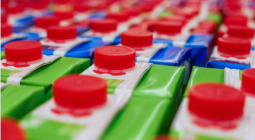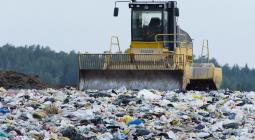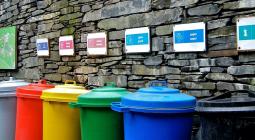How Recycling is the Biggest Brainwash of the Century.

4 reasons why you should quit it today
Most of the world associates recycling with environmentally-friendly. This is because recycling has always been marketed as a lifestyle with all the conveniences of plastic, without having to take any real responsibility.
But, the recycling system is broken. For many years, it has been used as a solution through marketing, for instance, the 2016 Pepsico campaign “give recycling 100%”. This isn’t the answer. As a society, we’ve been ignoring the other R’s that were taught to come first: reduce and reuse.
Marketers stray from these two because when you reduce what you buy or reuse what you already have, it hurts their revenue.
Other campaigns, like the 1990 Dupont has “pioneered the country’s largest most comprehensive plastic recycling program,” but are not recycling companies. They are fossil fuel companies — and plastic is made from fossil fuels.
These ads were paid for by fossil fuel companies who knew that plastic recycling would never be a solution. We know this because of a written document from a former industry consultant in April of 1973, exposing that the companies running these ads were manipulating the public with their greenwashing.
This marketing ploy has brainwashed our culture into believing that recycling is the answer. The scary truth? Only 8.7% of all plastic waste produced has been recycled.
Here are four of the biggest problems with recycling and why you should consider quitting it for good.
1. The Full Life Cycle isn’t held as important
When we talk about any system and its environmental impact, it’s important to take into account the full life cycle.
The first problem with plastic recycling and relying on recycling is that the material themselves are made from petroleum (a fossil fuel). The issues with petroleum are unavoidable if we continue to consume plastic at the rate that we do. It contributes to one of the most dangerous greenhouse gases (CO2) which adds to climate change, thus increasing the loss of biodiversity all across the globe.
The effects of climate changes via NASA:
- Temperatures will continue to rise
- Frost-free season will lengthen
- More droughts and heatwaves
- Hurricanes will become stronger
- Sea level will rise 1–8 feet by 2100
- The Arctic is likely to become ice-free
Take advantage of Reduce and Reuse
We should start taking more advantage of reducing and reusing. It seems like the shift towards only focusing on recycling was marketed to us by fossil fuel companies. This is something you can do on the consumer level: to reduce the amount of packaging that you’re buying, and either or, reuse the packaging that you are buying.
2. The Recycling is Limited
If you don’t know how recycling works, you might think you can recycle a plastic bottle over and over again and turn it into another plastic bottle. But, at best, a plastic bottle can only be recycled 10 times.
According to most experts, however, this is a generous amount. The National Geographic says the same piece of plastic can only be recycled about 2–3 times.
This is because each time plastic is recycled, it degrades in quality. Additionally, when things do contain plastic that is from recycled material, it needs virgin plastic to have a decent stable quality. Therefore, even if we recycle all the plastic ever produced, we would still depend on new petroleum-based plastic.
Recycled plastic isn’t valuable enough to be a practical option in the market. It is cheaper and better-quality to start fresh with virgin plastic, instead of recovering plastic and recycling it to turn it into a lower-quality product.
Encourage the Plastic Tax
By encouraging politicians to impose a Plastic Tax, it is charging companies who produce those lower-quality products. Because inevitably it becomes someone else’s responsibility to pay for them to be thrown away, which comes out of your trash costs.
We see this happening in the UK, which requires all producers of plastic to use 30% recycled content in their materials. Otherwise, there’s an import tax for materials made from only virgin plastics.
3. Plastic Contamination is getting worse
One of the biggest obstacles when it comes to recycling is contamination.
There are multiple levels of contamination, but one way this happens is by throwing unrecyclable types of plastics in with the recyclable. Nowadays, our curbside recycling may be taking one or two of these types, but you’re throwing in all of these different types of plastic and that is contaminating the entire batch.
Another type of contamination includes food waste, oils, greases, and liquids. With those on the recyclable material, it is impossible to get them clean enough to then recycle and turn them into new items.
Education
Contamination is a huge threat to the recycling system itself. We need more education systems and money put into resources from cities and towns to educate people on how to recycle and why it’s so important. We can educate ourselves on what’s going on with the rest of the world, and particularly with the environment.
4. Transitioning into a single-stream system
Most of the recycling that happens in the US does not happen within the country. Instead, they have been exporting most of those materials to China. However, in 2017 China closed its doors to accepting the US’s recycling.
This reaction came after many recycling programs have transitioned from separating papers, plastics, cans and bottles, to today’s single-stream system where it all goes into the same bin. As a result, contamination from food and waste has risen, leaving significant amounts of plastic unusable.
China has cut off imports of all but the cleanest and highest-grade materials imposing a 99.5% purity standard. This would mean the contamination rate was only able to be 0.5%, which is nearly impossible.
Better Sorting
What we need more of, and in higher quality, are MRF facilities. This is short for Materials Recovery Facilities, which sorts items so that we can separate the different types of plastics at a much greater rate. Overall, we would effectively reduce the contamination of materials.
Producer Responsibility
The final solution is “producer responsibility”. It can be done by enacting laws that say producers must take responsibility for their packaging, or companies must take responsibility for their packaging without having to be told by the government.
In conclusion, companies, governments and consumers, must all work together to create an economy that is not dependent on single-use plastics. But these solutions take time, and it begins with doing every little thing we can do to promote reduce and reuse for the world to sustain. You cannot do all the good the world needs, but the world needs all the good that you can do.
12 February 2021
Medium




